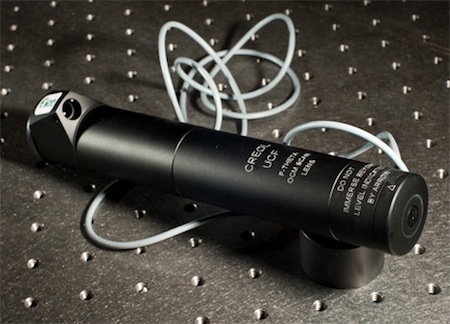Science Fiction
Dictionary
A B C D E F G H I J K L M N O P Q R S T U V W X Y Z
Liquid Lens For Optical Coherence Microscopy

A special medical scanner using a liquid lens has been developed at the University of Rochester. The device has already been tested successfully with humans in imaging skin lesions without the need for surgical removal and biopsy.

(Liquid lens for Optical Coherence Microscopy)
"My hope is that, in the future, this technology could remove significant inconvenience and expense from the process of skin lesion diagnosis," University of Rochester optics professor Jannick Rolland says. "When a patient walks into a clinic with a suspicious mole, for instance, they wouldn't have to have it necessarily surgically cut out of their skin or be forced to have a costly and time-consuming MRI done. Instead, a relatively small, portable device could take an image that will assist in the classification of the lesion right in the doctor's office."The device accomplishes this using a unique liquid lens setup developed by Rolland and her team for a process known as Optical Coherence Microscopy. In a liquid lens, a droplet of water takes the place of the glass in a standard lens. As the electrical field around the water droplet changes, the droplet changes its shape and therefore changes the focus of the lens. This allows the device to take thousands of pictures focused at different depths below the skin's surface. Combining these images creates a fully in-focus image of all of the tissue up to 1 millimeter deep in human skin, which includes important skin tissue structures. Because the device uses near infrared light instead of ultrasounds, the images have a precise, micron-scale resolution instead of a millimeter-scale resolution.
This device reminds me of the Star Trek medical scanners that are simply waved at the patient; the following compilation video should remind you.
(Str Trek medical scanner compilation video)
I also wanted to point out that the oil lens from Frank Herbert's 1965 novel Dune is a very early mention of the idea of manipulating the shape of a droplet of liquid.
Via Rochester University.
Scroll down for more stories in the same category. (Story submitted 2/27/2011)
Follow this kind of news @Technovelgy.| Email | RSS | Blog It | Stumble | del.icio.us | Digg | Reddit |
Would
you like to contribute a story tip?
It's easy:
Get the URL of the story, and the related sf author, and add
it here.
Comment/Join discussion ( 2 )
Related News Stories - (" Medical ")
BrainBridge Concept Transplant Of Human Head Proposed
'Briquet’s head seemed to think that to find and attach a new body to her head was as easy as to fit and sew a new dress.' - Alexander Belaev (1925)
Natural Gait With Prosthetic Connected To Nervous System
'The leg was to function, in a way, as a servo-mechanism operated by Larry’s brain...' - Charles Recour, 1949.
Brain Implant Is Able To Capture Your Inner Dialogue
'So you see, you can hide nothing from me.'
'Pregnancy Humanoids' From China Replace Moms
'A great many of these synthetic babies were made...' - David H. Keller, 1928.
Technovelgy (that's tech-novel-gee!) is devoted to the creative science inventions and ideas of sf authors. Look for the Invention Category that interests you, the Glossary, the Invention Timeline, or see what's New.
Science Fiction
Timeline
1600-1899
1900-1939
1940's 1950's
1960's 1970's
1980's 1990's
2000's 2010's
Current News
The Zapata Air Scooter Would Be Great In A Science Fiction Story
'Betty's slapdash style.'
Thermostabilized Wet Meat Product (NASA Prototype)
There are no orbiting Michelin stars. Yet.
Could Crystal Batteries Generate Power For Centuries?
'Power could be compressed thus into an inch-square cube of what looked like blue-white ice'
India Ponders Always-On Smartphone Location Tracking
'It is necessary... for your own protection.'
Amazon Will Send You Heinlein's Knockdown Cabin
'It's so light that you can set it up in five minutes by yourself...'
Is It Time To Forbid Human Driving?
'Heavy penalties... were to be applied to any one found driving manually-controlled machines.'
Replace The Smartphone With A Connected Edge Node For AI Inference
'Buy a Little Dingbat... electropen, wrist watch, pocketphone, pocket radio, billfold ... all in one.'
Artificial Skin For Robots Is Coming Right Along
'... an elastic, tinted material that had all the feel and appearance of human flesh and epidermis.'
Robot Guard Dog On Duty
I might also be thinking of K-9 from Doctor Who.
Wearable Artificial Fabric Muscles
'It is remarkable that the long leverages of their machines are in most cases actuated by a sort of sham musculature...'
BrainBridge Concept Transplant Of Human Head Proposed
'Briquet’s head seemed to think that to find and attach a new body to her head was as easy as to fit and sew a new dress.'
Google's Nano Banana Pro Presents Handwritten Math Solutions
'...copy was turned out in a charming and entirely feminine handwriting.'
Edible Meat-Like Fungus Like Barbara Hambly's Slunch?
'It was almost unheard of for slunch to spread that fast...'
Sunday Robotics 'Memo' Bot Has Unique Training Glove
'He then started hand movements of definite pattern...'
Woman Marries Computer, Vonnegut's Dream Comes True
'Men are made of protoplasm... Lasts forever.'
Natural Gait With Prosthetic Connected To Nervous System
'The leg was to function, in a way, as a servo-mechanism operated by Larry’s brain...'
